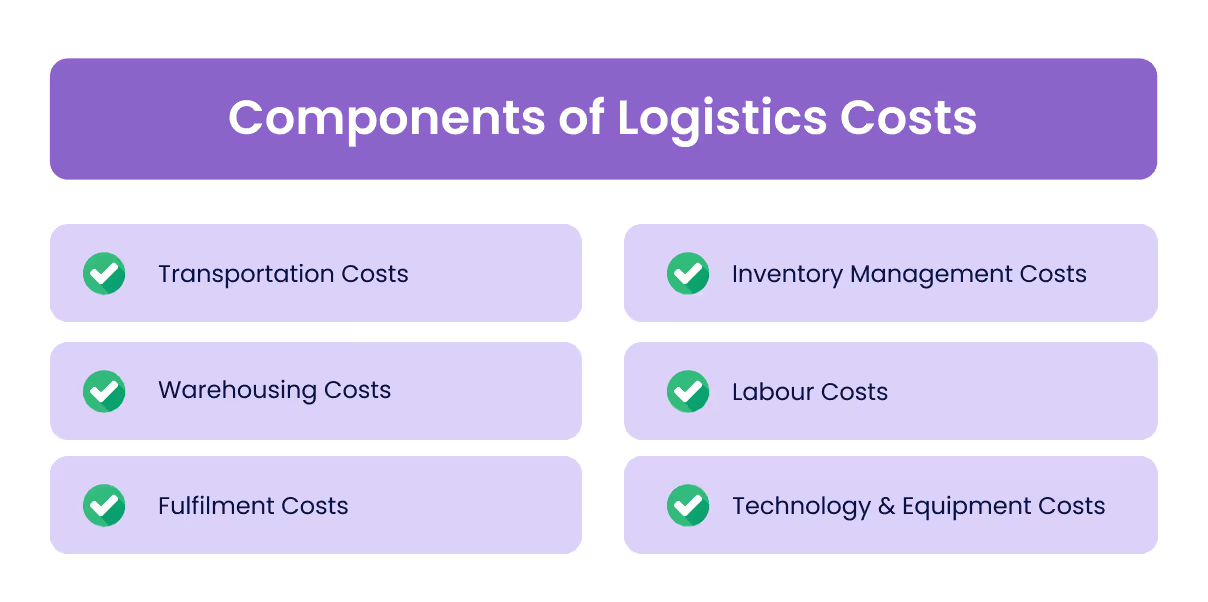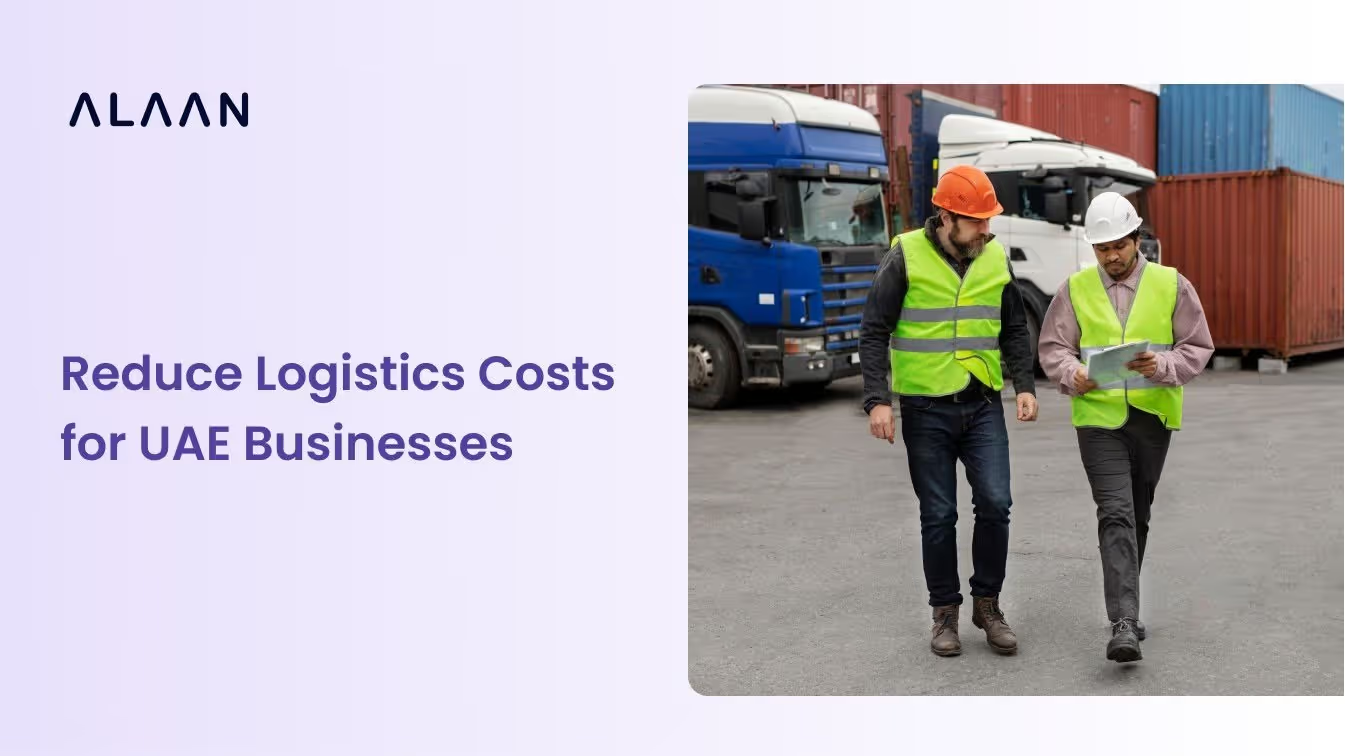The UAE’s transport and storage sector contributed AED 21.79 billion to GDP in Q1 2023, a 10.9% year-on-year increase, outpacing most other sectors. This growth underlines the strategic importance of logistics in the country’s non-oil economy. But as trade volumes rise and supply chains stretch across borders, logistics costs are climbing just as fast. Without structured controls, these expenses can severely impact profit margins, especially for businesses operating in high-volume import and export environments.
To stay competitive, UAE businesses must prioritise cost-efficient logistics operations. From fuel price volatility to last-mile inefficiencies, every overlooked detail adds to the bill. Reducing logistics spend is crucial for sustaining growth, meeting customer expectations, and maintaining a healthy bottom line.
This blog outlines practical strategies to reduce logistics costs, tailored to the UAE market. From freight consolidation to smart inventory planning and digitisation, each solution is based on real-world applications and expert insights.
What Are Logistics Costs?

Logistics costs encompass all expenses associated with moving goods throughout the supply chain, from sourcing raw materials to final delivery to the customer. For UAE-based businesses, particularly those involved in cross-border trade, logistics costs are a crucial component of operational expenses.
In the UAE, where logistics infrastructure supports high-volume trade via air, sea, and land, a clear understanding of these cost categories is essential for effective planning and cost control.
Here is a breakdown of the core components that make up logistics costs:
- Transportation Costs
Transportation is usually the largest and most visible portion of logistics spend. It covers expenses related to moving goods, either through an in-house fleet or outsourced providers such as freight carriers and third-party logistics (3PL) partners.
In the UAE, these costs are influenced by factors like fuel prices, toll fees, and international shipping rates through major ports like Jebel Ali.
- Warehousing Costs
Warehouse-related expenses include rental of storage space, utilities, equipment, and maintenance. For businesses operating in cities like Dubai or Abu Dhabi, warehousing costs can vary significantly depending on location and demand.
These costs may also include investments in warehouse management systems (WMS) and operational supplies, such as pallets, racking systems, and security.
- Fulfilment Costs
Fulfilment refers to the handling of orders, including receiving, picking, packing, and shipping. Businesses that do not operate their own fulfilment centres often outsource these functions.
Costs can include setup fees, packaging materials, order insert fees, custom labelling, and charges for handling returns. For e-commerce businesses in the UAE, selecting the right fulfilment partner can significantly impact both costs and customer satisfaction.
- Inventory Management Costs
Inventory-related expenses include the cost of procurement, storage, replenishment, and stock tracking. Poor inventory control can result in overstocking, obsolescence, or stockouts, all of which increase costs.
This is particularly relevant in the UAE, where many retailers and wholesalers manage multi-supplier inventories from across Asia, Europe, and Africa.
- Labour Costs
Labour is a significant but often underestimated logistics cost. It includes the salaries and benefits of warehouse staff, drivers, inventory managers, and customer service personnel.
In the UAE, labour costs also reflect regulatory requirements, such as work permits and visa expenses, making workforce planning a crucial aspect of cost optimisation.
- Technology and Equipment Costs
Investments in logistics tracking, automation, and management tools, such as barcode systems, fleet trackers, and inventory software, are key cost components that, despite their upfront expense, yield long-term savings through increased visibility and efficiency.
By understanding these components, UAE businesses can make informed decisions on where to cut costs, where to invest, and how to improve overall logistics performance. Each cost category requires its own strategy, but together, they provide a clear starting point for reducing logistics costs.
Why Reducing Logistics Spend Matters for Businesses in the UAE?
The UAE is a global logistics hub thanks to its strategic location and advanced infrastructure. However, businesses here face specific cost pressures that can affect their profitability, such as:
- Rising fuel and toll charges: Despite government subsidies, fuel prices and road tolls continue to increase, adding to transportation expenses.
- High warehousing costs: Free zones like Jebel Ali and Dubai South charge premium storage fees, which increase overall logistics budgets.
- Port congestion and customs delays: The UAE’s busy ports can experience congestion, causing storage and demurrage fees, as well as delayed deliveries.
For businesses in sectors such as FMCG, e-commerce, manufacturing, and construction, controlling logistics costs is essential. Here’s why it matters:
- Protect profit margins: Even small cost savings on high-volume shipments can lead to significant financial benefits.
- Maintain pricing competitiveness: Reducing logistics expenses enables companies to offer better prices without compromising margins.
- Improve customer satisfaction: Streamlined logistics enable faster and more reliable deliveries, boosting customer loyalty.
- Free up capital: Savings can be reinvested in product innovation, marketing, or digital transformation, which are key to growth in the UAE’s competitive market.
Reducing logistics costs protects margins and improves pricing flexibility and customer satisfaction, and frees up capital for growth. And with the right tools and strategies, these savings don’t have to come at the expense of quality or reliability.
Also Read: What is a Spend Management System?
Practical Strategies to Reduce Logistics Spend in the UAE

Controlling logistics costs is crucial to maintaining profitability and competitiveness in the UAE’s dynamic market. Companies adopting smart, targeted approaches can cut expenses without sacrificing service quality. Here are practical steps tailored to UAE businesses aiming to optimise logistics spend and enhance operational efficiency:
- Plan Long-Haul Transportation Efficiently
Transportation often represents the largest portion of a logistics budget. Effective high-level planning across cities or countries can significantly lower costs.
Consider these key tactics:
- Utilise Route Planning Software for Inter-Emirate or GCC Trips: Tools like Shipsy facilitate more efficient cross-border trip planning. They help identify shorter or less congested cross-emirate routes to reduce fuel use and time.
- Consolidate Shipments: Combining multiple less-than-truckload (LTL) shipments into full truckload (FTL) deliveries lowers per-unit transport costs and administrative workload.
- Select the Right Mode of Transport: For shipments within the GCC, road freight is generally more cost-effective and timely than air freight. Assess urgency, volume, and cost when deciding.
In the UAE, where businesses frequently transport goods between emirates or into Saudi Arabia, digital trip planning with real-time traffic updates can result in substantial savings.
- Streamline Last-Mile Delivery with Dynamic Routing
Static routing results in fuel waste and missed delivery windows in congested urban areas. Dynamic routing optimises deliveries in real-time for maximum efficiency.
Implement these strategies:
- Use AI-Powered Route Software: Integrate data on traffic, weather, and delivery time windows to optimise routes on the go.
- Automate Delivery Clustering: Group deliveries by geographic proximity to reduce distance travelled.
- Continuously Refine Routes: Update routing daily based on delivery volume and road conditions.
In cities like Dubai and Abu Dhabi, where traffic congestion can disrupt schedules, dynamic routing plays a key role in reducing the cost per delivery.
- Invest in Real-Time Shipment Visibility
Delays, reroutes, or missed deliveries silently increase logistics expenses. Real-time visibility tools solve this by providing end-to-end shipment tracking.
These tools help to:
- Reduce Manual Follow-Ups: Automated alerts notify logistics managers of route changes or delays.
- Improve Planning Accuracy: Real-time data supports smarter decisions, such as rerouting to avoid demurrage fees.
- Increase Accountability: Visibility benchmarks performance for internal teams and external partners.
Alaan supports this transparency with real-time expense visibility. Finance teams can track every logistics dirham spent and pinpoint inefficiencies early.
Also Read: Why do we even need Artificial Intelligence (AI)?
- Digitise and Streamline Warehouse Operations
Warehouse costs are often underestimated but can have a significant impact on total logistics spend. Poor layout, overstocking, and manual workflows add avoidable costs.
To improve warehouse efficiency:
- Use Inventory Management Software: Digitised stock control reduces holding costs and prevents stockouts.
- Forecast Demand Accurately: Predictive analytics minimises the need for emergency shipments or excess inventory.
- Implement Cross-Docking: Move goods directly from inbound to outbound transport to eliminate storage time.
Given the high storage fees in UAE free zones, warehouse optimisation offers direct cost reduction and faster fulfilment.
- Select Cost-Aligned Logistics Vendors
Your logistics provider can either reduce costs or create hidden inefficiencies. Strategic vendor selection is essential.
Adopt these best practices:
- Choose Transparent Providers: Prioritise those offering itemised billing, contract flexibility, and clear service levels.
- Audit Vendor Performance: Utilise KPIs to monitor delivery accuracy and cost, and renegotiate contracts if performance falls short.
- استخدم العطاءات التنافسية: قم بدعوة العديد من البائعين لتقديم عطاءات قبل وضع اللمسات الأخيرة على الأسعار. قارن ليس فقط التكلفة، ولكن أيضًا الموثوقية ونوافذ التسليم.
في بيئة الخدمات اللوجستية التنافسية في دولة الإمارات العربية المتحدة، يمكن لعلاقة المورد الملائمة أن تحقق وفورات طويلة الأجل.
- التدقيق الآلي للشحن وتسوية التكاليف
غالبًا ما تسمح عمليات سير عمل الفواتير اليدوية بأخطاء مثل الرسوم المزدوجة أو المعدلات غير الصحيحة أو عمليات رد الأموال المتأخرة. تعمل أتمتة عمليات تدقيق الشحن على التخلص من ذلك.
تساعد الأتمتة على:
- مطابقة الفواتير تلقائيًا: قارن بيانات الشحن الفعلية مع أسعار شركات النقل للإبلاغ عن الاختلافات.
- اكتشف أخطاء التكلفة مبكرًا: حدد التأخيرات أو الرسوم الإضافية أو التكاليف غير المعتمدة قبل تصاعدها.
- تسريع دورات الموافقة: تعمل تدفقات الموافقة الرقمية على تقليل الاختناقات والجهد اليدوي.
والنتيجة هي انخفاض العمالة وتقليل نزاعات الدفع وزيادة الدقة المالية.
- تقليل تكاليف الخدمات اللوجستية العكسية
يمكن أن تصل تكلفة الإرجاع إلى ضعف التسليم الأصلي. يمكن أن يؤدي تحسين الخدمات اللوجستية العكسية إلى خفض التكاليف بشكل كبير، خاصة في قطاع التجارة الإلكترونية المزدهر في الإمارات العربية المتحدة.
تكتيكات التبني:
- تأكد من دقة الطلب: استخدم ماسحات الباركود والتحقق الرقمي لتجنب أخطاء الانتقاء.
- تبسيط عمليات الإرجاع: تقديم عمليات ملائمة للعملاء من خلال نقاط التسليم المحلية أو الخزائن.
- أعد التخزين بسرعة: قم بإرجاع العناصر إلى المخزون على الفور لتقليل عمليات الشطب والتقادم.
تعمل عملية الإرجاع المبسطة أيضًا على تحسين رضا العملاء وولاء العلامة التجارية.
- خفض تكاليف التغليف
يؤثر حجم العبوة ووزنها بشكل مباشر على النفقات اللوجستية. تزيد الصناديق كبيرة الحجم أو المواد الثقيلة من رسوم الشحن دون داع.
إليك كيفية خفض هذه التكاليف:
- استخدم مواد خفيفة الوزن ومتينة: تقليل وزن كل شحنة دون المساس بالحماية.
- تصميم الحزم ذات الحجم المناسب: تخصيص الأبعاد لحجم المنتج لتجنب رسوم الوزن الإضافية للأبعاد.
- قم بالتبديل إلى الخيارات الصديقة للبيئة: تتوافق العبوات القابلة لإعادة التدوير أو القابلة للتحلل مع القوانين البيئية لدولة الإمارات العربية المتحدة وتلبي توقعات العملاء.
التغليف الأكثر ذكاءً يقلل التكلفة والبصمة الكربونية.
- اعتماد استراتيجية الأسطول الهجين المرنة
يمكن أن يكون تشغيل أسطول مملوك بنسبة 100٪ غير فعال خلال فترات الطلب المتقلب. يوفر النموذج الهجين المرونة.
الممارسات الموصى بها:
- تأجير المركبات بشكل موسمي: زيادة سعة الأسطول خلال شهر رمضان أو العودة إلى المدرسة أو غيرها من فترات الطلب المرتفع.
- استخدم برامج تشغيل Gig Economy: انقر على منصات التسليم الجماعية لتلبية احتياجات الميل الأخير في المدن.
- حافظ على الأسطول الأساسي للأحمال التي يمكن التنبؤ بها: استخدم المركبات الداخلية للطرق المستقرة أو الشحنات عالية القيمة.
توفر هذه الاستراتيجية المرونة دون تكبد تكاليف ثابتة على مدار العام، مما يجعلها مثالية لتقلبات الطلب في الإمارات العربية المتحدة.
- تحسين نجاح المحاولة الأولى في التسليم
عمليات التسليم الفاشلة تضيع الوقت والمال. يعد تحسين النجاح في المحاولة الأولى أمرًا أساسيًا لخفض التكاليف اللوجستية.
لتعزيز نجاح المحاولة الأولى:
- استخدم جدولة التسليم القائمة على الذكاء الاصطناعي: قم بتحسين فترات التسليم من خلال مواءمتها مع توفر العملاء باستخدام الأدوات التنبؤية.
- الإشعارات التلقائية: قم بتأكيد عمليات التسليم عبر الرسائل القصيرة أو WhatsApp أو تطبيقات الهاتف المحمول مسبقًا.
- استخدم ذكاء الموقع: قم بتعيين برامج التشغيل بناءً على قرب GPS وبيانات الموقع في الوقت الفعلي.
وهذا مفيد بشكل خاص في المراكز الحضرية الكثيفة مثل دبي، حيث تكون النوافذ الزمنية ضيقة ويختلف مدى توفر العملاء.
من خلال تنفيذ الاستراتيجيات المذكورة أعلاه، يمكن للشركات الإماراتية تقليل الإنفاق اللوجستي مع الحفاظ على موثوقية الخدمة. ومع ذلك، فإن مواءمة العمليات مع السياق التنظيمي والاقتصادي المحلي يمكن أن تحقق وفورات أكبر.
نصائح إضافية لسوق الإمارات
إن توطين الاستراتيجيات اللوجستية وفقًا للبيئة الاقتصادية والتنظيمية والبنية التحتية في دولة الإمارات العربية المتحدة يؤدي إلى تحقيق وفورات إضافية:
- استخدم المناطق الحرة بشكل استراتيجي: تقدم جافزا وكيزاد ومناطق أخرى التأجيل الجمركي وتحسين ضريبة القيمة المضافة.
- استثمر في التخزين المحلي: تخزين البضائع بالقرب من نقاط التسليم في دبي أو أبو ظبي يقلل من تكاليف النقل بين المدن.
- مخاطر التحوط للعملات: يجب على الشركات التي تستورد السلع بالدولار الأمريكي أو اليورو مراقبة اتجاهات صرف العملات الأجنبية واستخدام أدوات التحوط لإدارة تعرضها.
تعمل هذه الأساليب المحلية على تقليل التكاليف مع دعم شبكات توصيل أسرع وأكثر مرونة.
اقرأ أيضًا: فرصة أم إزعاج؟ - تتبع انبعاثات الكربون في التمويل
كيف تساعد Alaan في تقليل الإنفاق اللوجستي؟
في Alaan، ندرك أن الخدمات اللوجستية لا تتعلق فقط بنقل البضائع، بل تتعلق بالتحكم في كل درهم يتم إنفاقه عبر سلسلة التوريد الخاصة بك. في منطقة مثل الإمارات العربية المتحدة، حيث يمكن أن تتقلب تكاليف النقل ورسوم التخزين ورسوم الموردين يوميًا، يعد التحكم المالي في الوقت الفعلي أمرًا ضروريًا.
منصة إدارة النفقات المدعومة بالذكاء الاصطناعي من Alaan يعمل على تمكين فرق الخدمات اللوجستية والمالية بأدوات دقيقة للحد من تسرب التكاليف وتحسين عملية صنع القرار:
- تتبع الإنفاق اللوجستي في الوقت الفعلي: احصل على رؤية بنسبة 100٪ لنفقات الشحن والشحن والجمارك عبر الأقسام والبائعين وطرق التسليم.
- اعتماد النفقات آليًا: قم بإنشاء عمليات سير عمل متعددة المستويات لإدارة فواتير الشحن الكبيرة أو رسوم الشحن المخصصة. يمكن تخصيص الموافقات حسب القسم أو المبلغ أو البائع.
- تصنيف التكاليف اللوجستية تلقائيًا: يقوم محرك Alaan بالذكاء الاصطناعي بتصنيف كل معاملة، سواء من وكيل شحن أو بائع وقود، تحت مركز التكلفة المناسب أو المشروع أو المنطقة.
- فرض ضوابط الميزانية: قم بتعيين حدود الاستخدام للبطاقات اللوجستية. تحكم في مكان وزمان وكيفية إنفاق كل فريق أو بائع، دون إشراف يدوي.
- قم بالمزامنة مع برنامج المحاسبة الخاص بك: قم باستيراد بيانات المصروفات تلقائيًا إلى ERP لتقليل وقت الإغلاق الشهري. يقترح Alaan أيضًا رموز GL الدقيقة وفئات الضرائب، مما يساعد الشركات الإماراتية على البقاء متوافقة مع ضريبة القيمة المضافة.
- إنشاء تقارير جاهزة للتدقيق: مع تسجيل جميع النفقات اللوجستية وتصنيفها، يمكنك إنشاء تقارير متوافقة مع التدقيق على الفور، وهي مثالية لعمليات التدقيق المالي أو مراجعات المستثمرين أو عمليات تدقيق التكاليف الداخلية.
من الشحنات العابرة للحدود التي تنطلق من جافزا إلى عمليات التسليم في المرحلة الأخيرة في جميع أنحاء الإمارات العربية المتحدة، توفر ألان للشركات الإماراتية الشفافية والأتمتة اللازمة لتقليل الإنفاق اللوجستي دون إدارة دقيقة.
أفكار نهائية
يتطلب خفض الإنفاق اللوجستي في الإمارات أكثر من مجرد خفض التكاليف التفاعلي؛ فهو يتطلب اتخاذ قرارات استباقية تعتمد على البيانات. مع تزايد الضغوط التشغيلية وتوقعات العملاء المتزايدة، لم تعد الشركات قادرة على تحمل أوجه القصور في عمليات النقل أو التخزين أو التسليم.
تقدم كل استراتيجية تمت مناقشتها هنا، عند دمجها مع الرؤية في الوقت الفعلي والأتمتة، طريقة عملية للسيطرة على التكاليف اللوجستية دون التضحية بجودة الخدمة. لكن التنفيذ هو المفتاح، وهذا هو المكان الذي يمكن أن يساعد فيه آلان.
شركة آلان تتيح منصة النفقات المدعومة بالذكاء الاصطناعي للشركات الإماراتية التحكم الكامل في التكاليف اللوجستية عبر كل مسار وفاتورة ومورد.
هل أنت مستعد لتبسيط التحكم في تكاليف الخدمات اللوجستية؟ احجز نسخة تجريبية مجانية مع Alaan وأطلق العنان لرؤية الإنفاق بنسبة 100% والموافقات الآلية والتكامل المحاسبي السلس اليوم.
الأسئلة الشائعة
س: ما هو أكبر مساهم في تكاليف الخدمات اللوجستية في دولة الإمارات العربية المتحدة؟
أ. عادةً ما يكون النقل هو أكبر تكلفة لوجستية، خاصة بالنسبة للشركات التي تنقل البضائع عبر الإمارات أو إلى المملكة العربية السعودية. تؤدي أسعار الوقود المتقلبة ورسوم المرور وعدم كفاءة المسار إلى زيادة هذه التكلفة بشكل كبير.
س: كيف تضمن Alaan الامتثال لقوانين ضريبة القيمة المضافة في دولة الإمارات العربية المتحدة للنفقات اللوجستية؟
أ. يلتقط Alaan تفاصيل ضريبة القيمة المضافة تلقائيًا من الفواتير ويقترح الرموز الضريبية الصحيحة. وهذا يضمن تصنيف نفقاتك اللوجستية بشكل صحيح وجاهز لعمليات تدقيق اتفاقية التجارة الحرة أو الإيداعات الضريبية.
س: هل يمكن لشركة Alaan مساعدة الشركات التي تستخدم شركاء الخدمات اللوجستية الخارجيين (3PL)؟
أ. نعم. يتتبع Alaan جميع النفقات المدفوعة لبائعي 3PL، ويصنفها حسب نوع الخدمة (الشحن والتخزين وما إلى ذلك)، ويساعد في تحديد أي زيادة في الفواتير أو الرسوم المكررة أو ارتفاع التكاليف بمرور الوقت.
س: هل شركة Alaan مناسبة للشركات التي تدير الخدمات اللوجستية عبر مواقع متعددة في الإمارات العربية المتحدة؟
أ. بالتأكيد. يتيح لك Alaan تخصيص بطاقات الإنفاق والميزانيات حسب الفرع أو المنطقة أو القسم. يمكنك تتبع الإنفاق اللوجستي بين الإمارات بشكل منفصل وضبط الضوابط حسب الحاجة.
س: كم من الوقت يستغرق تنفيذ Alaan لتتبع النفقات اللوجستية؟
أ. يمكن أن تبدأ معظم الشركات في الإمارات العربية المتحدة العمل في غضون أيام قليلة. تقدم Alaan الإعداد السريع والدعم المحلي والتكامل مع أنظمة المحاسبة الشائعة المستخدمة في المنطقة.


.avif)







%201.avif)